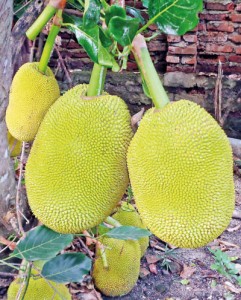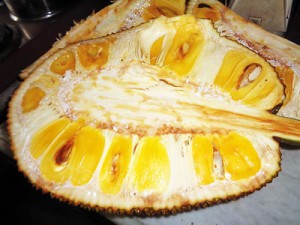Jakfruit- the jackpot
View(s):By Dr. Nirmala M. Pieris
The grafted Jakfruit tree in our back garden is laden with fruits. For many years now, we have enjoyed these fruits and also shared with friends and family. Jakfruit, Artocarpus heterophyllus (Sinhalese – kos or herali, Tamil – pelaka) belongs to the family Moraceae. In Sri Lanka the tree is naturally grown in scattered cultivations and in home gardens throughout the country. The seasons can vary depending on rainfall but productions can be through the year.
 The tree is evergreen, with dark green oval shaped leaves with almost all the parts of the tree secreting white sticky latex when damaged. Jakfruit is the largest known treeborne fruit with the fruit growing on the branches and trunks. Even a small jakfruit weighs over 5kg and specimens of over 45kg have been recorded.
The tree is evergreen, with dark green oval shaped leaves with almost all the parts of the tree secreting white sticky latex when damaged. Jakfruit is the largest known treeborne fruit with the fruit growing on the branches and trunks. Even a small jakfruit weighs over 5kg and specimens of over 45kg have been recorded.
The outer surface of the fruit is covered with blunt thorn like projections, which becomes soft as the fruit ripens.The edible bulbs within are interspersed between thin bands of fibres.The bulbs enclose a smooth, oval, light-brown seed. The immature fruit is called ‘polos’ in Sri Lanka and is curried, pickled or prepared into ‘mallung’, which is a preparation with grated coconut. The cream coloured bulbs of the mature unripe fruits are either boiled with the seeds and eaten with scraped coconut or cooked with coconut milk into a curry and eaten with rice. They can also be dried, fried or pickled. It is also used as a filling for cutlets.
The bulbs of the ripe fruits known in Sinhalese as ‘waraka’ (hard variety) or ‘wela’ (softer variety) are yellow to orange and emit a strong sweet fruity smell. The ripe fruit is highly perishable and best when consumed fresh. The bulbs can be preserved in sugar syrup, made into juice, smoothies or ice cream or even used to make jams, jellies, cookies and muffins. The seeds are edible with a milky sweet taste and can be eaten, boiled, roasted, fried, curried or ground into flour.
Nutritional benefits
The jakfruit is a nutritional jackpot. It is rich in carbohydrates and has good amounts of sugars such as fructose and sucrose. The fruit also containing significant quantities of dietary fibre is a good source of antioxidant vitamin-C and is one of the rare fruits that are rich in the B-complex group of vitamins such as pyridoxine (vitamin B6), niacin (vitamin B3), riboflavin (vitamin B2) and folic acid. The fresh fruit has small but significant amounts of vitamin A and the flavonoid pigments beta carotene, lutein and zeaxanthin. It is also a good source of iron and contains important minerals such as magnesium, calcium, potassium, phosphorous, copper, zinc and manganese. The fruit is low in sodium and saturated fats. The seeds are a good source of starch and dietary fibre.
 Boosts energy
Boosts energy
As the fruit is rich in carbohydrates and contain fructose and sucrose that are absorbed readily and easily by our bodies, eating the fruit gives an immediate energy boost. A bowl of ripe jakfruit as a post-workout snack will help you to recover quickly.
Aids digestion
Jakfruit is rich in dietary fibre that bulk up stools and keep them soft so that they can easily pass through the digestive system. The fibre content also helps protect the colon mucous membrane by binding to and eliminating cancer-causing chemicals from the colon.
Optimizes immune system
Due to the dense concentration of vitamin C, the fruit is a high grade antioxidant that increases immune system function and thus provides resistance against infections. Further, the antioxidant properties and high water content of the jakfruit keeps skin healthy, moisturized and reduces wrinkles and dryness.
Promotes heart health
The fruits contain potassium, which is essential in controlling blood pressure and heart rate. Jakfruits are also a good source of vitamin B6, which is excellent for heart health, builds immunity and prevents strokes.
Good for vision
The vitamin A and the flavonoid pigments in the fruit play vital roles in vision functions. Vitamin A is critical for good eyesight and also supports the normal functioning of the cornea and conjunctival membranes. Lutein and zeaxanthin protect and maintain healthy cell function and reduce the risk of cataract, glaucoma and macular degeneration.
Alleviates anaemia
Jakfruit contains iron that can combat the deficiency of red blood cells in the blood. The vitamin C content further enables an efficient absorption of iron in the body. Other minerals like copper and magnesium in the fruit improves the quality of blood.
Fights diabetes
One of the most powerful health benefits associated with jackfruit is its ability to fight diabetes. Consumption of mature unripe jakfruit is believed to reduce insulin dependency of patients due to the low glycemic index, high dietary fibre, especially the insoluble fibre and the possibility to eat large quantities as a meal and satiate a hungry diabetic patient.
Supports bone health
The calcium in the fruit strengthens and promotes healthy bones. The potassium helps to reduce calcium loss through the kidney and this in turn increases bone density making people less prone to problems such as arthritis and osteoporosis. Jakfruits are also a good source of magnesium, which is required for the proper absorption of calcium. Modest amounts of manganese, phosphorous and zinc in the fruit are minerals required for optimum bone health.
Promotes thyroid function
The copper in the fruit contributes towards the strengthening of the thyroid hormones and thus protects the body from problems such as goitre.
Jakfruit for pregnant and breastfeeding women
As jakfruit, is loaded with nutrients it is actually beneficial during pregnancy and breastfeeding. An advantage is the vitamin A content that is crucial for proper cell production, eyesight, and fetal development. As a rich source of vitamin B3 the fruit helps regulate hormones, boost immunity and controls stress levels. However over-consumption must be avoided as it can lead to stomach upsets due to its high fibre content.


